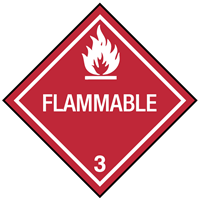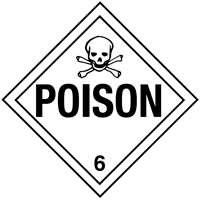
 Print
Print
Chemical Datasheet
CARBON DISULFIDE |


|
Chemical Identifiers
| CAS Number |
UN/NA Number |
DOT Hazard Label |
USCG CHRIS Code |
- 75-15-0

|
|
|
|
| NIOSH Pocket Guide |
International Chem Safety Card |
|
Carbon disulfide
|
|
NFPA 704
General Description
A clear colorless to light yellow volatile liquid with a strong disagreeable odor. Flammable over a wide vapor/air concentration range (1%-50%). Vapors are readily ignited; the heat of a common light bulb may suffice. Insoluble in water and more dense than water. Hence sinks in water. Vapors are heavier than air. Used in the manufacture of rayon and cellophane, in the manufacture of flotation agents and as a solvent.
Hazards
Reactivity Alerts
Air & Water Reactions
Highly flammable. Insoluble in water.
Fire Hazard
Ignition temperature is dangerously low. Vapors may be ignited by contact with an ordinary (incandescent) light bulb. When heated to decomposition, it emits highly toxic fumes of oxides of sulfur. When heated to decomposition, emits highly toxic fumes of sulfur oxides and can react vigorously with oxidizing materials. Avoid air, rust, halogens, metal azides, metals, oxidants; when exposed to heat or flame reacts violently with aluminum, chlorine, azides, hypochlorite, ethylamine diamine, ethylene imine, fluorine, metallic azides of lithium, potassium, cesium, rubidium and sodium, nitrogen oxides, potassium, zinc and (sulfuric acid plus permanganate). Decomposes on standing for a long time. (EPA, 1998)
Health Hazard
The material affects the central nervous system, cardiovascular system, eyes, kidneys, liver, and skin. It may be absorbed through the skin as a vapor or liquid, inhaled or ingested. The probable oral lethal dose for a human is between 0.5 and 5 g/kg or between 1 ounce and 1 pint (or 1 pound) for a 70 kg (150 lb.) person. In chronic exposures, the central nervous system is damaged and results in the disturbance of vision and sensory changes as the most common early symptoms. Lowest lethal dose for humans has been reported at 14 mg/kg or 0.98 grams for a 70 kg person. Alcoholics and those suffering from neuropsychic trouble are at special risk. (EPA, 1998)
Reactivity Profile
CARBON DISULFIDE has an extremely low autoignition temperature. May ignite or even explode when heated. The vapor or liquid has been known to ignite on contact with steam pipes, particularly if rusted [Anon., J. Roy. Inst. Chem., 1956, 80, p.664]. Explosion hazard when exposed to flame, heat, sparks or friction. Mixtures with lithium, sodium, potassium or dinitrogen tetraoxide may detonate when shocked. Potentially explosive reaction with nitrogen oxide, chlorine, permanganic acid(strong oxidizing agents). Vapor ignites in contact with aluminum powder or fluorine. Reacts violently with azides, ethylamine ethylenediamine, ethylene imine. Emits highly toxic fumes of oxides of sulfur when heated to decomposition [Bretherick, 5th ed., 1995, p. 663]. Sodium amide forms toxic and flammable H2S gas with CS2. (714)
Belongs to the Following Reactive Group(s)
Potentially Incompatible Absorbents
No information available.
Response Recommendations
Isolation and Evacuation
Excerpt from ERG Guide 131 [Flammable Liquids - Toxic]:
IMMEDIATE PRECAUTIONARY MEASURE: Isolate spill or leak area for at least 50 meters (150 feet) in all directions.
SPILL: Increase the immediate precautionary measure distance, in the downwind direction, as necessary.
FIRE: If tank, rail tank car or highway tank is involved in a fire, ISOLATE for 800 meters (1/2 mile) in all directions; also, consider initial evacuation for 800 meters (1/2 mile) in all directions. (ERG, 2024)
Firefighting
If the vapor concentration exceeds 2 percent by volume or is unknown, self-contained breathing mask with full face should be used by all persons entering contaminated area. Wear special protective clothing. Isolate for 1/2 mile in all directions if tank car or truck is involved in fire.
Use dry chemical, carbon dioxide or other inert gas. Cooling and blanketing with water spray is effective in case of fires in metal containers or tanks to help prevent reignition by hot surfaces. Foam is ineffective. (EPA, 1998)
Non-Fire Response
Excerpt from ERG Guide 131 [Flammable Liquids - Toxic]:
ELIMINATE all ignition sources (no smoking, flares, sparks or flames) from immediate area. All equipment used when handling the product must be grounded. Do not touch or walk through spilled material. Stop leak if you can do it without risk. Prevent entry into waterways, sewers, basements or confined areas. A vapor-suppressing foam may be used to reduce vapors.
SMALL SPILL: Absorb with earth, sand or other non-combustible material and transfer to containers for later disposal. Use clean, non-sparking tools to collect absorbed material.
LARGE SPILL: Dike far ahead of liquid spill for later disposal. Water spray may reduce vapor, but may not prevent ignition in closed spaces. (ERG, 2024)
Protective Clothing
Excerpt from NIOSH Pocket Guide for Carbon disulfide:
Skin: PREVENT SKIN CONTACT - Wear appropriate personal protective clothing to prevent skin contact.
Eyes: PREVENT EYE CONTACT - Wear appropriate eye protection to prevent eye contact.
Wash skin: WHEN CONTAMINATED - The worker should immediately wash the skin when it becomes contaminated.
Remove: WHEN WET (FLAMMABLE) - Work clothing that becomes wet should be immediately removed due to its flammability hazard (i.e., for liquids with a flash point <100°F).
Change: No recommendation is made specifying the need for the worker to change clothing after the workshift. (NIOSH, 2024)
DuPont Tychem® Suit Fabrics
Normalized Breakthrough Times (in Minutes)
| Chemical |
CAS Number |
State |
QS |
QC |
SL |
C3 |
TF |
TP |
RC |
TK |
RF |
| Carbon disulfide |
75-15-0 |
Liquid |
imm |
imm |
imm |
imm |
>480 |
>480 |
>480 |
>480 |
>480 |
Special Warning from DuPont: Tychem® and Tyvek® fabrics should not be
used around heat, flames, sparks or in potentially flammable or
explosive environments. Only...
(DuPont, 2024)
First Aid
Warning: Effects may be delayed. Caution is advised.
Signs and Symptoms of Acute Carbon Disulfide Exposure: Acute exposure to carbon disulfide primarily affects the central nervous system producing signs and symptoms that may include headache, dizziness, difficulty swallowing, nervousness, tremors, mental depression, delirium, psychosis, convulsions, paralysis, and coma. Nausea, vomiting, cyanosis (blue tint to skin and mucous membranes), hypothermia (low body temperature), and peripheral vascular collapse may also occur. Respiratory effects include coughing, dyspnea (shortness of breath), and respiratory failure. Carbon disulfide is a strong skin irritant; dermal exposure may result in severe burns. Eye exposure may cause degeneration of the retina and optic nerve. Pupils may be dilated.
Emergency Life-Support Procedures: Acute exposure to carbon disulfide may require decontamination and life support for the victims. Emergency personnel should wear protective clothing appropriate to the type and degree of contamination. Air-purifying or supplied-air respiratory equipment should also be worn, as necessary. Rescue vehicles should carry supplies such as plastic sheeting and disposable plastic bags to assist in preventing spread of contamination.
Inhalation Exposure:
1. Move victims to fresh air. Emergency personnel should avoid self-exposure to carbon disulfide.
2. Evaluate vital signs including pulse and respiratory rate, and note any trauma. If no pulse is detected, provide CPR. If not breathing, provide artificial respiration. If breathing is labored, administer oxygen or other respiratory support.
3. Obtain authorization and/or further instructions from the local hospital for administration of an antidote or performance of other invasive procedures.
4. Transport to a health care facility.
Dermal/Eye Exposure:
1. Remove victims from exposure. Emergency personnel should avoid self- exposure to carbon disulfide.
2. Evaluate vital signs including pulse and respiratory rate, and note any trauma. If no pulse is detected, provide CPR. If not breathing, provide artificial respiration. If breathing is labored, administer oxygen or other respiratory support.
3. Remove contaminated clothing as soon as possible.
4. If eye exposure has occurred, eyes must be flushed with lukewarm water for at least 15 minutes.
5. Wash exposed skin areas three times. Wash initially with soap and water follow with an alcohol wash, then wash again with soap and water.
6. Obtain authorization and/or further instructions from the local hospital for administration of an antidote or performance of other invasive procedures.
7. Transport to a health care facility.
Ingestion Exposure:
1. Evaluate vital signs including pulse and respiratory rate, and note any trauma. If no pulse is detected, provide CPR. If not breathing, provide artificial respiration. If breathing is labored, administer oxygen or other respiratory support.
2. Obtain authorization and/or further instructions from the local hospital for administration of an antidote or performance of other invasive procedures.
3. Give the victims water or milk: Children up to 1 year old, 125 mL (4 oz or 1/2 cup); children 1 to 12 years old, 200 mL (6 oz or 3/4 cup); adults, 250 mL (8 oz or 1 cup). Water or milk should be given only if victims are conscious and alert.
4. Activated charcoal may be administered if victims are conscious and alert. Use 15 to 30 g (1/2 to 1 oz) for children, 50 to 100 g (1-3/4 to 3-1/2 oz) for adults, with 125 to 250 mL (1/2 to 1 cup) of water.
5. Promote excretion by administering a saline cathartic or sorbitol to conscious and alert victims. Children require 15 to 30 g (1/2 to 1 oz) of cathartic; 50 to 100 g (1-3/4 to 3-1/2 oz) is recommended for adults.
6. Transport to a health care facility. (EPA, 1998)
Physical Properties
Flash Point:
-22°F
(EPA, 1998)
Lower Explosive Limit (LEL):
1 %
(EPA, 1998)
Upper Explosive Limit (UEL):
50 %
(EPA, 1998)
Autoignition Temperature:
194°F
(ICSC, 2024)
Melting Point:
-167°F
(EPA, 1998)
Vapor Pressure:
360 mmHg
at 77°F
(EPA, 1998)
Vapor Density (Relative to Air):
2.67
(EPA, 1998)
- Heavier than air; will sink
Specific Gravity:
1.2632
at 68°F
(EPA, 1998)
- Denser than water; will sink
Boiling Point:
116°F
at 760 mmHg
(EPA, 1998)
Molecular Weight:
76.13
(EPA, 1998)
Water Solubility:
less than 1 mg/mL
at 68°F
(NTP, 1992)
Ionization Energy/Potential:
10.08 eV
(NIOSH, 2024)
IDLH:
500 ppm
(NIOSH, 2024)
AEGLs (Acute Exposure Guideline Levels)
Final AEGLs for Carbon disulfide (75-15-0)
| Exposure Period |
AEGL-1 |
AEGL-2 |
AEGL-3 |
| 10 minutes |
17 ppm |
200 ppm |
600 ppm |
| 30 minutes |
17 ppm |
200 ppm |
600 ppm |
| 60 minutes |
13 ppm |
160 ppm |
480 ppm |
| 4 hours |
8.4 ppm |
100 ppm |
300 ppm |
| 8 hours |
6.7 ppm |
50 ppm |
150 ppm |
(NAC/NRC, 2024)
ERPGs (Emergency Response Planning Guidelines)
| Chemical |
ERPG-1 |
ERPG-2 |
ERPG-3 |
| Carbon Disulfide (75-15-0)
|
1 ppm  |
50 ppm |
500 ppm |
(AIHA, 2022)
PACs (Protective Action Criteria)
| Chemical |
PAC-1 |
PAC-2 |
PAC-3 |
|
| Carbon disulfide (75-15-0)
|
13 ppm |
160 ppm |
480 ppm |
LEL = 13000 ppm |
(DOE, 2024)
Regulatory Information
EPA Consolidated List of Lists
| Regulatory Name |
CAS Number/
313 Category Code |
EPCRA 302
EHS TPQ |
EPCRA 304
EHS RQ |
CERCLA RQ |
EPCRA 313
TRI |
RCRA
Code |
CAA 112(r)
RMP TQ |
| Carbon disulfide |
75-15-0 |
10000 pounds |
100 pounds |
100 pounds |
313 |
P022 |
20000 pounds |
(EPA List of Lists, 2024)
CISA Chemical Facility Anti-Terrorism Standards (CFATS)
|
RELEASE |
THEFT |
SABOTAGE |
| Chemical of Interest |
CAS Number |
Min Conc |
STQ |
Security
Issue |
Min Conc |
STQ |
Security
Issue |
Min Conc |
STQ |
Security
Issue |
| Carbon disulfide |
75-15-0 |
1.00 % |
20000 pounds |
toxic |
|
|
|
|
|
|
(CISA, 2007)
OSHA Process Safety Management (PSM) Standard List
No regulatory information available.
Alternate Chemical Names
- CARBON BISULFIDE
- CARBON BISULPHIDE
- CARBON DISULFIDE
- CARBON DISULFIDE (CARBON BISULFIDE)
- CARBON DISULPHIDE
- CARBON SULFIDE
- CARBON SULFIDE (CS2)
- CARBON SULPHIDE
- DITHIOCARBONIC ANHYDRIDE
- NCI-C04591
- SULPHOCARBONIC ANHYDRIDE
- SULPHURET OF CARBON
- WEEVILTOX



 Print
Print

